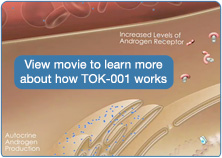
Programs
Many complex diseases, such as cancer, involve cellular growth abnormalities regulated by the endocrine system. Based upon proprietary insight into the complexities of the endocrine system, Tokai is building a pipeline of therapeutics focusing initially on castration resistant prostate cancer (CRPC).
Tokai’s lead drug candidate, TOK-001, is a small molecule, oral drug that disrupts the growth and survival of cancer cells by attacking three specific targets in the prostate cancer tumor, providing a novel and proprietary triple mechanism of action for the treatment of prostate cancer. In preclinical studies, TOK-001 acts as an androgen receptor antagonist, as a CYP17 lyase inhibitor and decreases androgen receptor levels in prostate tumors – the only drug in development that has been shown to exhibit this property. In TOK-001, these three distinct mechanisms of action are combined in one therapy.
a novel and proprietary triple mechanism of action for the treatment of prostate cancer. In preclinical studies, TOK-001 acts as an androgen receptor antagonist, as a CYP17 lyase inhibitor and decreases androgen receptor levels in prostate tumors – the only drug in development that has been shown to exhibit this property. In TOK-001, these three distinct mechanisms of action are combined in one therapy.
In addition, Tokai has an early stage pipeline of other assets focused on semparatide, a synthetic version of parathyroid hormone-related peptide, for improved engraftment in hematopoietic stem cell (HSC) transplantation; and specific progesterone receptor modulators, or SPRMs, for the treatment of uterine fibroids.
About Galeterone
Galeterone is a highly selective, multi-targeted, oral small molecule, drug candidate for the treatment of prostate cancer that disrupts androgen receptor (AR) signaling, the key driver of prostate cancer growth, via multiple mechanisms of action.
Galeterone molecular structure pictured above.
Galeterone acts by disrupting the androgen receptor signaling pathway, which is the primary pathway that drives prostate cancer growth. The pathway is ordinarily activated by the binding of male hormones, or androgens, such as testosterone and the more potent androgen dihydrotestosterone, or DHT, to the ligand binding domain of androgen receptors in prostate cancer cells. Galeterone disrupts the activation of the pathway through multiple mechanisms of action:
- inhibition of the enzyme CYP17, which blocks the synthesis of testosterone;
- androgen receptor antagonism, which blocks the binding of testosterone or DHT with the androgen receptor; and
- androgen receptor degradation, which reduces the amount of androgen receptor protein in the tumor cells.
Tokai is focused on the initial development of galeterone for the treatment of patients with castration resistant prostate cancer (“CRPC”) whose prostate tumor cells express an altered androgen receptor that is truncated. Galeterone’s unique multiple mechanisms of action, including androgen receptor degradation, provides an opportunity to treat patients where the truncated androgen receptors are missing the end of the receptor that contains the ligand binding domain. Patients with these truncated androgen receptors are described as having C-terminal loss. An example of one such truncated androgen receptor with C-terminal loss is the splice variant AR-V7, which is the most prevalent of the splice variants that cause C-terminal loss. In these patients, the lack of a functional ligand binding domain causes the truncated androgen receptor to be constitutively active, or continuously signaling, meaning that activation of the androgen receptor pathway and tumor growth occurs even in the absence of androgens and androgen binding.
Interim data from Tokai’s ongoing Phase 2 clinical trial of galeterone, ARMOR2, included four patients who were identified as having altered androgen receptors that were truncated, all of whom showed clinically meaningful PSA reductions of at least 50 percent. Although initial development of galeterone is focused on the treatment of CRPC patients whose prostate tumor cells express an altered androgen receptor that is truncated, Tokai is conducting the ARMOR2 trial of galeterone in multiple CRPC patient populations.
Galeterone has received Fast Track designation from the U.S. Food and Drug Administration (FDA).
